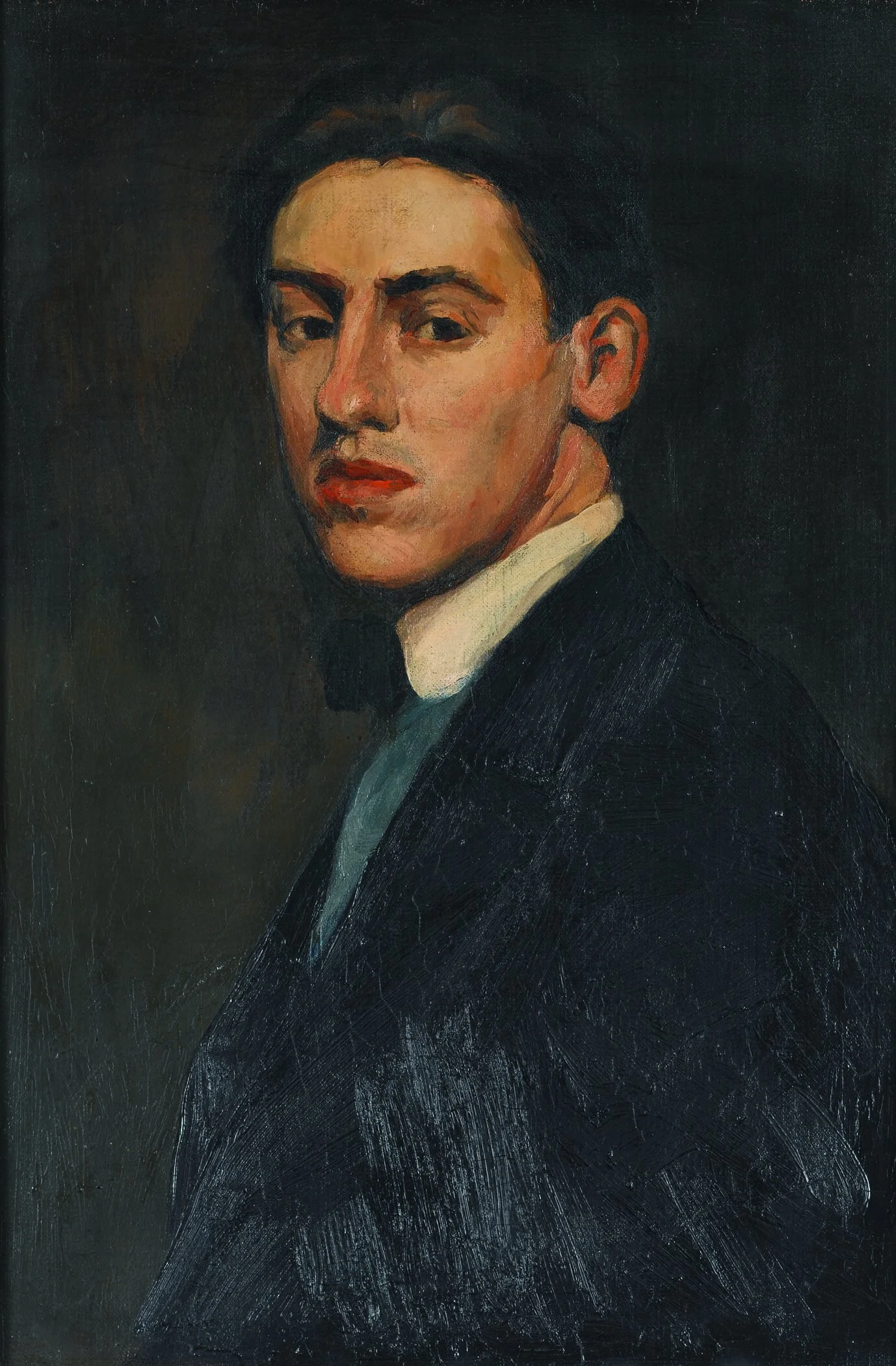Born in Lancaster, Pennsylvania, Charles Demuth moved with his family to the 18th century brick row home on East King Street at the age of 6. Here, in his home and studio, Demuth created over 1,000 artworks, many of which were inspired by the people, places, and things he encountered in his hometown.
Demuth traveled extensively and his art was energized by his experiences. As an artist and a gay man in the early 20th century, Demuth’s social and professional circles included that of the avant-garde art and queer communities.
Demuth’s creativity abounded in various forms and he became a master watercolorist. However, some of his most significant contributions to art history were painted in other mediums. These include Precisionist paintings, adaptated from Cubism principles, and Poster Portraits layered with symbolism.
Charles Demuth’s legacy as a pioneer in American Modernism continues to captivate and inspire today.
English captions and Spanish subtitles available under Settings [cog wheel icon].
View Video Transcript (English) (PDF) | Transcripción de Vídeo (Español) (PDF)
Demuth Museum Reinterpretation Project
Introduction
Now over 40-years-old, the Demuth Foundation has done tremendous work to preserve and promote the legacy of Modernist painter Charles Demuth (1883-1935) in Lancaster, PA. The Foundation started as a grassroots effort to convert the artist’s home and studio into a museum in the early 1980s, and today boasts the largest collection of his work, attracts audiences from across the globe, and is a member of the National Trust for Historic Preservation’s Historic Artists’ Home and Studio program.
In 2022, the Foundation began work to incorporate unaddressed or underrepresented themes within its interpretation of Charles Demuth and our historic site. Our audiences’ appetite for more information and deeper engagement is growing, and we want to meet their enthusiasm and provide more content to discuss Demuth and his work more fully. Previous interpretation at our Museum has included Demuth’s influence on American Art, his colleagues and peers in the Modern Art movement, and 19th and early 20th century life in Lancaster. Foundation publications have emphasized Demuth’s relationships (Charles Demuth and Friends, 2003) and his travels (Out of the Chateau, 2007). This is a look into the personhood of Charles Demuth—his personality, his lifestyle, the traits that influenced his life and work.
With funding from the National Trust for Historic Preservation’s Telling the Full History Preservation Fund, with support from the National Endowment for the Humanities, we embarked on a research project to explore the themes of Demuth’s relationship to the LGBTQ+ community of his time and how disability and disease may have impacted his artwork. It is important to note that this is not the first time these topics have been discussed, but this is the first formal inquiry and report by the Foundation in these areas. It is also imperative to state that this work is an ongoing process as we get to know Charles Demuth more fully.
Our methodology for this research project emphasized bringing outside expert voices to the table to discuss and present their findings and analysis. An independent public historian and researcher, Dr. Susan Ferentinos, was contracted to prepare a report answering the following questions:
What did a homosexual lifestyle look like for early 20th century artists in America? How did queer culture manifest and vary in communities that Charles Demuth lived in or visited?
What evidence exists to support the assumption that Charles Demuth was gay? Is there documentation that would support or discredit this claim?
We also invited 10 art scholars and curators from across the country to contribute an essay that analyzes one of Demuth’s works of art. Five responded affirmatively and have submitted articles that highlight a variety of Demuth’s work through fresh lenses. They were asked to select one of Charles Demuth’s pieces and draft a short essay conveying their interpretation and analysis of the work and how his sexuality or disability may have impacted the piece. We’ve also invited Franklin & Marshall College American Studies and Women's, Gender and Sexuality Studies professor Alison Kibler to share some of her findings on Lancaster vice and the environments Charles Demuth would have encountered while “in the Province.”
At the onset of our project, we partnered with the YWCA of Lancaster for a gender and sexuality training and discussion on the ethics of posthumously “outing” historic figures. The YWCA has also reviewed our compiled research and offered a local perspective for our reinterpretation project.
In addition, staff has done a significant amount of reading and research to inform and guide our project. A list of those resources is included in this document.
The following is a compilation of our acquired research from April 2022 through March 2023. This information will inform the next steps of our reinterpretation at the Demuth Museum.
Abby Baer
Executive Director, Demuth Foundation
This project has been funded by National Trust for Historic Preservation’s Telling the Full History Preservation Fund, with support from National Endowment for the Humanities. Any views, findings, conclusions or recommendations expressed in this publication/website do not necessarily represent those of the National Trust or the National Endowment for the Humanities.
Scholar Bios
Susan Ferentinos, PhD
Susan Ferentinos is a public history researcher, writer, and consultant, specializing in project management for historical organizations and LGBTQ and women’s history. Her clients have included the American Association for State and Local History, the Center for Sexual Health Promotion, the National Council on Public History, and numerous historic sites and programs of the National Park Service. In 2012-2014, she served as a project manager and subject specialist for the National Park Service Women’s History Initiative. Ferentinos is the author of Interpreting LGBT History at Museums and Historic Sites (Rowman & Littlefield, 2015), which won the 2016 book award from the National Council on Public History, and has a chapter on interpreting sexuality in the book Reimagining the Historic House Museum: Catalysts for Change, edited by Ken Turino and Max Van Balgooy. Ferentinos holds a PhD in United States history from Indiana University, with a focus on the history of gender and sexuality.
Barbara Haskell
Barbara Haskell is an American art historian and a museum curator. She is currently a curator at the Whitney Museum of American Art, where she has worked since 1975.
Her area of expertise is early to mid-20th-century painting and sculpture, including American Modernists, Abstract Expressionists, and Pop artists. She is the founder and leader of the American Fellows, a patrons group for major donors to the Whitney.
In addition to the landmark thematic exhibitions she has curated, she has curated retrospectives and authored accompanying scholarly monographs on a range of early-20th-century and post-war American artists, including Marsden Hartley (1980), Charles Demuth (1987), Agnes Martin (1992), Joseph Stella (1994), Edward Steichen (2000), Elie Nadelman (2003), Georgia O'Keeffe (2009), Robert Indiana (2013), Stuart Davis (2016), and Grant Wood (2018).
Jonathan D. Katz, PhD
Jonathan D. Katz is a founding figure in queer art history, responsible for the very first queer scholarship on a number of artists. His scholarship spans a period from the late 19th-century to the present, with an emphasis on the US, but with serious attention to Europe, Latin America and Asia as well. He has written extensively about gender, sexuality and desire, producing some of the key theoretical work in queer studies in the visual arts. His books include Hide/Seek: Difference and Desire in American Portraiture and Difference/Indifference: Musings on Postmodernism, Marcel Duchamp and John Cage, which was co-authored with Moira Roth. Katz is widely known for his many essays that constitute the first queer studies scholarship on artists as diverse as Jasper Johns, Leon Polk Smith, Robert Indiana, John Cage, Agnes Martin, Georgia O'Keeffe, and Robert Rauschenberg.
Alison Kibler, PhD
M. Alison Kibler is a professor of American Studies and Women's, Gender & Sexuality Studies at Franklin and Marshall College. She is the author of Rank Ladies: Gender and Cultural Hierarchy in American Vaudeville (1999) which traces women's central roles in the audience, on stage, and in the labor movement of the most popular live entertainment of the early twentieth century. She was recently awarded the Rachel Fuchs Memorial Award for Excellence in Mentorship and Service to Women/LGBTQ in the Profession, Coordinating Council for Women in History in 2020 and is currently facilitating F&M students with a Lancaster Vice History tour.
Erin Pauwels, PhD
Erin Pauwels is an assistant professor of American Art at Temple University and an historian of American art and visual culture with special interest in photography and media theory. Her research explores the politics of visuality in the 19th and 20th centuries by mapping intersections between elite and popular forms of expression across evolving technologies for circulating, consuming, and reproducing images.
Her forthcoming book, Napoleon Sarony and the Art of Living Pictures, reconstructs the complex legacy of a once-famous, nineteenth-century artist to reveal how the expansion of mass media and celebrity culture reshaped the public life of photographs as well as modern notions of artistic authorship and visual literacy. Other publications include articles on portraiture and Cuban-US migrant experience; the hybrid media operations of painted photographic backdrops; and the entangled histories of theater, early film, and fine art.
Jonathan Frederick Walz, PhD
An expert on American modernism, Jonathan Frederick Walz is Director of Curatorial Affairs and Curator of American Art at The Columbus Museum, Georgia. He received an MA and a PhD—both in art history—from the University of Maryland, College Park. He has published essays and given lectures on a range of topics, from Charles Demuth and Alma W. Thomas to conceptual portraiture and queer rurality. As a proponent of object-based study and public history, Walz has over 25 years of experience in art museums, including more than a decade of service at the National Gallery of Art, Washington.
Keri Watson, PhD
Keri Watson is an Associate Professor of Art History: Modern and Contemporary Art, American Studies, Museum Studies, Higher Education in Prisons at the University of Central Florida. She serves as a co-executive editor for Panorama: Journal of the Association of Historians of American Art and teaches courses in 19th- and 20th-century art, American art, the art of Disney and self-taught artists, and African American Art. Dr. Watson's research, which focuses on the power of art to contribute to and challenge stereotypical representations of race, nationality, gender, sex, and disability, has been recognized and supported by a Fulbright Fellowship and grants from the National Endowment for the Arts, the Terra Foundation of American Art, the Institute of Museum and Library Services, and the Society for the Preservation of American Modernists.
Research compilation
Click on the thumbnails or links beneath the thumbnails to read or download the essays. Essays will download in a PDF format.





